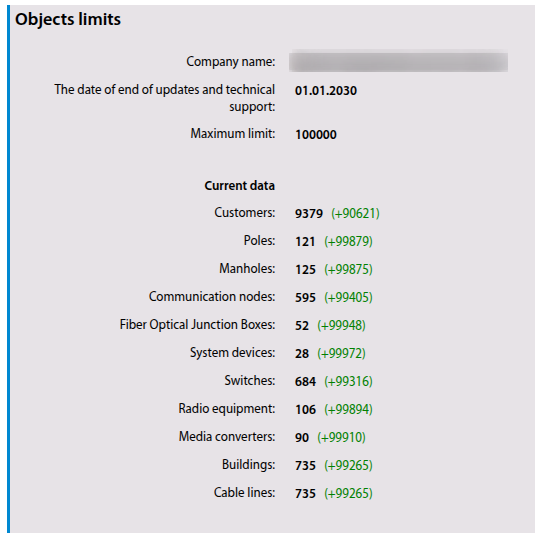Objects limits
The price policy for ERP "UserSide" sales and service is based, among other things, on the volume of the company that uses the system.
The larger the size of the enterprise, the more information is stored in the system and the more effort is required to maintain that enterprise. For example, there will be more people working in the enterprise who will make more use of the product's functionality, request information on technical support, and submit requests for improvement. More data will require additional work to optimise the program, advice on customisation, etc.
With a stated volume of 20,000 objects, the company has the ability to keep records of each type of object in quantities of 20,000.For example, connect 20,000 users AND install 20,000 communication nodes AND add 20,000 switches etc.
From version 3.12, the actual use of limits can be seen under "Settings - Main - Objects limits".

Until the end of 2015, all USERSIDE systems were sold without ranking by limits and for the same price for all. There was a difficult situation where small providers were not able to purchase the product and for large companies the costs were negligible. This is why a limit gradation has been introduced. All "old" customers who have purchased the unlimited edition of the system can use it for any number of objects, but they choose their own annual limit and pay for it on that basis. This means that this year the client can pay for updates at a rate of "3000" objects, next year at a rate of "20,000" objects, etc. "New" customers do not have this option and need to pay separately - to extend their licence to the required limit.
Information update dated 22.11.2019:
We are not yet including "Former users" in the limit with users at this stage. You can use an unlimited number of them. However, it should be understood that some of the overall functionality of the system, which is related to all users, will still be limited depending on the limits. For example - inventory items can be transferred and accounted for on both "standard" users and former users. However, when issuing an inventory report - information on users will be issued according to the limit (whether they are former users or not). Therefore - some users will not be included in this report. etc.
Information update dated 27.02.2020:
A limit on the number of houses/buildings is to be understood as a limit on any addressable objects of particular types. That is, with a limit of "3000" objects in the system, 3000 houses AND 3000 streets AND 3000 localities and 3000 objects of any kind can be entered.
Information update dated 04.07.2025:
Since version 3.20, the restriction on limits of houses/buildings and other addressable objects has been removed